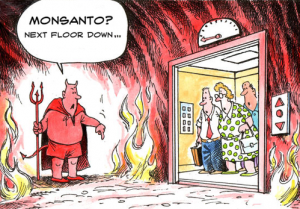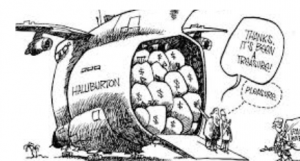
Photo courtesy of torange.biz CC/BY
Corruption in Corporations
English teacher Jennifer Kim asked us to publish the standout research papers written by her students in Senior English. The following is a paper written by Cindy Chau.
History has saturated and tainted humanity with an overwhelming amount of scandals and fraudulent crimes that has occurred since the beginning of time. In fact, as early as 44 B.C, Julius Caesar was betrayed by his very own friend, Brutus, who stabbed him to death because he believed his friend was not fit to be ruler of Rome. Greed and fraud, two of the many circles of hell described in Dante’s Inferno, has spawned the creation of the despicable deed shamefully called corruption, which has led to humanity’s incessant fraudulent and sinful behavior. Thus, unequivocally, corruption is bound to occur within society, whether in government, schools, big companies, or even in families. “Power tends to corrupt and absolute power corrupts absolutely,” quoted by Lord Acton, describes how having power corrupts man or lessens their morality, and the more power he has, the more corrupt he will become. People with power are bound to commit an act of fraud, and it happens often in companies. Beneath the dirty surface of powerful and wealthy companies such as Monsanto and Halliburton, lies the foundation and framework built from a tangent web of lies and fraud— concealed from the public eyes of the American people.
Starting in the early 1900s, a lonely pharmaceutical veteran, John Francis Queeny, founded Monsanto, where it would later become one the world’s largest agricultural biotechnology corporation known today for its Roundup and genetically engineered (GE) seeds. (“Who is Monsanto?”) Throughout its history, Monsanto has developed an abundance of chemical products which were later banned such as DDT, PCBs, and Agent Orange. This has left the public to consider if Monsanto deliberately produced these chemicals knowing the dangers and health consequences, or if they were clueless and unknowingly released these toxic chemicals to the world, which still exist today. During the late 1930s, Monsanto began to expand into industrial chemicals and drugs, which led them to produce a chemical known as polychlorinated-biphenyls or PCBs, used in hundreds of industrial and commercial applications such as coolants in air conditioners. They were widely used from the 1930s to 1970s until it was banned when the Environmental Protection Agency found it was a highly toxic chemical:
PCBs were considered an industrial wonder chemical – an oil that would not burn, was impervious to degradation and had almost limitless applications. Today PCBs are considered one of the gravest chemical threats on the planet. PCBs, widely used as lubricants, hydraulic fluids, cutting oils, waterproof coatings and liquid sealants, are potent carcinogens and have been implicated in reproductive, developmental and immune system disorders. The world’s center of PCB manufacturing was Monsanto’s plant on the outskirts of East St. Louis, Illinois, which has the highest rate of fetal death and immature births in the state (“Monsanto’s Dark History”).
Additionally, the U.S. Environmental Protection Agency says, “PCB has been demonstrated to cause cancer, as well as a variety of other adverse health effects on the immune system, reproductive system, nervous system and endocrine system.”(“Monsanto’s Dark History”). To make matters worse, new documents and internal records that have been released by Poison Papers Project have shown that Monsanto previously known about the effects of PCBs before they were legally declared illegal by the EPA (Neslen). In one memo, the company stated that PCBs “cannot be considered non-toxic.” Moreover, a Harvard study conducted in 1937 was the first to find that prolonged exposure to PCBs could cause liver damage and a rash called chloracne (Grunwald). Monsanto warned its industrial customers to protect its workers from the toxic fumes: “Avoid repeated contact with the skin and inhalation of the fumes and dusts.” and even warned them of ecological risks: “If the material is discharged in large concentrations it will adversely affect . . . aquatic life in the stream.” (Grunwald). However, the public community was kept hidden in the dark, until it was announced that PCBs were highly toxic chemicals that could produce carcinogenic effects on the human body and was declared illegal. While Monsanto no longer produces chemicals, its promise that their genetically engineered crops are safe for human consumption has left some people in doubt and suspicion. Mike Casey, part of the Environmental Working Group states, “For years, these guys said PCBs were safe, too, but there’s obviously a corporate culture of deceiving the public.”
Fig. 1. This graphic depicts that Monsanto’s infamous lies to the public can go straight to hell. (“Monsanto? Next Floor Down..”)
Founded in 1919, Halliburton, considered one the world’s largest oil and gas company today, with operations in more than 70 countries is painted as a gnarly giant corporation that has engaged in shameless war profiteering from charging outrageous prices to provide fuel for Iraqis to meals for American troops. One of Halliburton’s former subsidiary company known as Kellogg, Brown and Root or KBR held one of the largest multi-billion dollar contract called the Logistics Civilian Augmentation Program or LOGCAP during the Iraq War to provide an undefined quantity and an undefined value of “selected services in wartime” (Vine). The company continuously worked for the war effort for nearly eight more years without facing a competitor’s bid due to a series of one-year contract extensions. This evidently meant that KBR was in a no-bid contract with the government. No-bid contracts encourages fraud and corruption because only one source or company is picked by the government to spend on to provide a product or service. Traditionally, companies compete by sending in proposals and their costs to provide their service and the government picks the most cost-efficient one (Williams). Without full and open competition, fraud, bribery and collusion are bound to occur. The political cartoon drawn by Mike Keefe aptly presents a comedic viewpoint on Halliburton’s profiteering from the Iraq war effort (see fig.2).
Fig. 2. This political cartoon suggests that Halliburton was profiting from the Iraq War from government contracts. (Keefe)
That is exactly what happened to KBR when it was accused of fraud, that it “knowingly included impermissible costs” in its bills (Holan). Then in April 2010, the US Department of Justice filed a civil fraud case against KBR over the issue that the company was using private security forces in Iraq to protect its workers and subcontractors and alleges that internal documents showed that KBR executives knew private security wasn’t allowed but charged for it anyway. Under the LOGCAP contract, private security was not allowed because the US was supposed to provide protection. However, KBR argues that the government had known for years that the company was hiring private security and only did so because its employees were left unprotected by the military. In a response by KBR:
KBR believes the costs incurred and actions taken by the company and its subcontractors to provide support and to protect its employees and subcontractors were reasonable, necessary and appropriate under the contractual arrangement between KBR and the Army. … The Army breached the contract by repeatedly failing to provide the necessary force protection (Holan).
Whether or not, KBR intentionally made mistakes and overcharged the government, there is an air of fraudulence and disinformation—mixed lethally for the public to inhale—and there is no doubt that some pockets and bank accounts were secretly being filled during that time.
To conclude, money plays a key role in the face of corruption. This has contributed to several cases of shady deals done by companies, where they were able to enormously benefit from them. In fact, money has also changed the political power in government. Richard Goodwin argues that business corporations and and wealthy individuals have successfully purchased influence and votes in America’s government through their financial contributions to political offices and parties and believes that money has corrupted the American Political System. Thus, these businesses and individuals are able to accumulate access and influence to persuade or even coerce elected officials who can pass laws or policies that will in turn make profit and earnings for them. It is a win-win situation for both parties. For the politician, votes are guaranteed, while businesses gain profit and the protection of future earnings. Therefore, it is apparent that corruption occurs profusely in political and corporate affairs and is not a rare phenomenon to occur.
IMAGE:
Works Cited
Dudley, William. Political Scandals: Opposing Viewpoints. San Diego, California: Greenhaven
Press, 2001. Print.
Grunwald, Michael. “Monsanto Hid Decades of Pollution.” Commondreams.org. The
Washington Post. 1 January 2002. Web. 16 April 2018.
Hanzai, E. “The Complete History of Monsanto, “The World’s Most Evil Corporation.”
GlobalResearch.ca. 8 March 2018. Web. 11 April 2018.
Holan, Angie Drobnic. “Halliburton, KBR, and Iraq War Contracting: A History so Far.”
Politifact.com. Poynter Institute, 9 June 2010. Web. 12 April 2018.
Keefe, Mike. “Halliburton Treasure.” Intoon.com. N.p. 7 July 2006. Web. 16 April 2018.
“Monsanto’s Dark History: 1901-2011.” bestmeal.info.com. N.p. n.d. Web. 11 April 2018.
“Monsanto? Next Floor down..” AnonymousArt of Revolution.com. N.p. 23 September 2013.
Web. 16 April 2018.
Neslen, Arthur. “Monsanto sold banned chemicals for years despite known health risks, archives
reveal.” The Guardian.com. Guardian News and Media Limited., 10 August 2017. Web. 11 April 2018.
Vine, David. “The $385 Billion Military-Industrial Boondoggle You’ve Never Heard Of.”
TheNation.com. The Nation Company., 14 May 2013. Web. 16 April 2018.
Williams, David. “Feds’ rampant use of no-bid contracts the essence of corruption.” The
Hill.com. Capitol Hills Publishing Corp., 1 August 2017. Web. 10 April 2018.
“Who is Monsanto?” WhoisMonsanto.com. WordPress Theme, n.d. Web. 11 April 2018.


